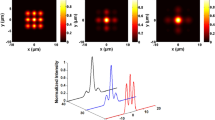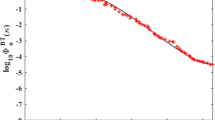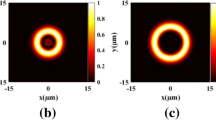Abstract
Aiming at the Bessel higher-order cosh-Gaussian beam and the Bessel higher-order sinh-Gaussian beam, we investigate their propagation properties through turbulent biological tissues. In this respect, the analytical expression of the considered beams is obtained and developed, based on the extended Huygens-Fresnel integral. By numerical simulation, the axial intensity of these beams for biological tissue types including the intestinal epithelium and deep dermis of the mouse in addition the human upper dermis versus the propagation distance as a function of the variations of the laser beam parameters. The obtained results indicate that the resistance of our beams against turbulent biological tissues increases as the source parameter increases counting the decentered parameter, the beam-order of the considered beams and the beam waist width. The findings show that the intensity distribution of the propagation of these beams occurs more quickly when they pass through the deep dermis of the mouse. The results presented in this paper are significant due to their potential application in determining the deterioration or disruption of biological tissue, medical imaging and medical diagnosis.











Similar content being viewed by others
Data availability
No datasets is used in the present study.
References
Abramowitz, M., Stegun, I.: Handbook of mathematical functions with formulas, graphs, and mathematical tables. U. S Department of Commerce, Washington, DC (1970)
Andrews, L.C., Phillips, R.L.: Laser beam propagation through random media, 2nd edn. SPIE, Bellingham, WA, USA (2005)
Baykal, Y.: Intensity correlation of collimated Gaussian beams propagating in biological tissues. J. Mod. Opt. 68, 108–115 (2021)
Bayraktar, M.: Propagation of partially coherent hyperbolic sinusoidal Gaussian beam in biological tissue. Optik 245, 167741–167748 (2021)
Benzehoua, H., Belafhal, A.: The effects of atmospheric turbulence on the spectral changes of diffracted pulsed hollow higher-order cosh-Gaussian beam. Opt. Quant. Electron. 50, 973–982 (2023a)
Benzehoua, H., Saad, F., Belafhal, A.: Spectrum changes of pulsed chirped generalized Hermite cosh-Gaussian beam through turbulent biological tissues. Optik 294, 1–10 (2023b)
Chib, S., Belafhal, A.: Analyzing the spreading properties of vortex beam in turbulent biological tissues. Opt. Quant. Electron. 55, 98–116 (2023)
Dalil-Essakali, L., Nossir, N., Belafhal, A.: Axial intensity of Bessel higher-order cosh-Gaussian beam propagating in a turbulent atmosphere. Opt. Quant. Electron. 56, 1–15 (2023)
De Boer, J.F., Milner, T.E., Van Gemert, M.J., Nelson, J.S.: Two-dimensional birefringence imaging in biological tissue by polarization-sensitive optical coherence tomography. Opt. Lett. 22, 934–936 (1997)
Ebrahim, A.A.A., Belafhal, A.: Effect of the turbulent biological tissues on the propagation properties of coherent Laguerre-Gaussian beams. Opt. Quant. Electron. 53, 179–196 (2021)
Gao, W.: Changes of polarization of light beams on propagation through tissue. Opt. Commun. 260, 749–754 (2006)
Gao, W., Korotkova, O.: Changes in the state of polarization of a random electro-magnetic beam propagating through tissue. Opt. Commun. 270, 474–478 (2007)
Gbur, G.: Partially coherent beam propagation in atmospheric turbulence. J. Opt. Soc. Am. A 31, 2038–2045 (2014)
Gökçe, M.C., Baykal, Y.: Aperture averaging and BER for Gaussian beam in underwater oceanic turbulence. Opt. Commun. 410, 830–835 (2018a)
Gökçe, M.C., Baykal, Y.: Effects of liver tissue turbulence on propagation of annular beam. Optik 171, 313–318 (2018b)
Gökçe, M.C., Baykal, Y., Ata, Y.: Laser array beam propagation through liver tissue. J. vis. 23, 331–338 (2020)
Gradshteyn, I.S., Ryzhik, I.M.: tables of integrals, series, and product, 5th edn. Academic Press, New York (1994)
Hitzenberger, C.K., Götzinger, E., Sticker, M., Pircher, M., Fercher, A.F.: Measurement and imaging of birefringence and optic axis orientation by phase resolved polarization sensitive optical coherence tomography. Opt. Express 9, 780–790 (2001)
Ishimaru, A.: Wave propagation and scattering in random media, vol. 1. Academic Press, New York, NY, USA (1978)
Lu, X., Zhu, X., Wang, K., Zhao, C., Cai, Y.: Effects of biological tissues on the propagation properties of anomalous hollow beams. Optik 127, 1842–1847 (2016)
Mallidi, S., Luke, G.P., Emelianov, S.: Photoacoustic imaging in cancer detection, diagnosis, and treatment guidance. Trends Biotechnol. 29, 213–221 (2011)
Martelli, M.P., Sozzi, G., Hernandez, L., Pettirossi, V., Navarro, A., Conte, D., Falini, B.: Eml-4-Alk rearrangement in non-small cell lung cancer and non-tumor lung tissues. Am. J. Pathol. 174, 661–670 (2009)
Meiling, D., Chao, Z., Jinhong, L.: Coherence and polarization properties of laser propagating through biological tissues. J. Photochem. Photobiol. b. 172, 88–94 (2017)
Ni, Y., Zhou, Y., Zhou, G., Chen, R.: Characteristics of partially coherent circular flattened Gaussian vortex beams in turbulent biological tissues. Appl. Sci. 9, 969–983 (2019)
Nossir, N., Dalil-Essakali, L., Belafhal, A.: Behavior of the central intensity of generalized Humbert-Gaussian beams against the atmospheric turbulence. Opt. Quant. Electron. 53, 1–3 (2021)
Nossir, N., Dalil-Essakali, L., Belafhal, A.: Effects of weak to moderate atmospheric turbulence on the propagation properties of the Whittaker-Gaussian laser beam. Opt. Quant. Electron. 56, 1–13 (2023a)
Nossir, N., Dalil-Essakali, L., Belafhal, A.: Introduction of Bessel higher-order cosh-Gaussian beam and its propagation through a paraxial ABCD optical system. Opt. Quant. Electron. 55, 1–16 (2023b)
Saad, F., Belafhal, A.: A theoretical investigation on the propagation properties of hollow Gaussian beams passing through turbulent biological tissues. Optik 141, 72–82 (2017)
Schmitt, J.M., Kumar, G.: Turbulent nature of refractive-index variations in biological tissue. Opt. Lett. 21, 1310–1312 (1996)
Wu, Y., Zhang, Y., Wang, Q., Hu, Z.: Average intensity and spreading of partially coherent model beams propagating in a turbulent biological tissue. J. Quant. Spectrosc. Radiat. Transf. 184, 308–315 (2016)
Xie, S., Li, H., Lu, Z.: Overview of tissue optics. Physics 27, 599–604 (1998)
Xu, M.: Plum pudding random medium model of biological tissue toward remote microscopy from spectroscopic light scattering. Biomed. Opt. Express 8, 2879–2895 (2017)
Xu, M., Alfano, R.R.: Fractal mechanisms of light scattering in biological tissue and cells. Opt. Lett. 22, 3051–3053 (2005)
Yu, L., Zhang, Y.: Beam spreading and wander of partially coherent Lommel-Gaussian beam in turbulent biological tissue. J. Quant. Spectrosc. Radiat. Transf. 217, 315–320 (2018)
Zhang, Y., Zhou, X., Yuan, X.: Performance analysis of sinh-Gaussian vortex beams propagation in turbulent atmosphere. Opt. Commun. 440, 100–105 (2019)
Zhang, H., Cui, Z., Han, Y., Guo, J., Chang, C.: Average intensity and beam quality of Hermite-Gaussian correlated schell-model beams propagating in turbulent biological tissue. Front. Phys. 9, 650537–650546 (2021)
Funding
No funding is received from any organization for this work.
Author information
Authors and Affiliations
Contributions
All authors contributed to the study conception and design. All authors performed simulations, data collection and analysis and commented the present version of the manuscript. All authors read and approved the final manuscript.
Corresponding author
Ethics declarations
Competing interests
The authors declare no competing interests.
Conflict of interest
The authors have no financial or proprietary interests in any material discussed in this article.
Ethical approval
This article does not contain any studies involving animals or human participants performed by any of the authors. We declare this manuscript is original, and is not currently considered for publication elsewhere. We further confirm that the order of authors listed in the manuscript has been approved by all of us.
Consent to participate
Informed consent was obtained from all authors.
Consent for publication
The authors confirm that there is informed consent to the publication of the data contained in the article.
Additional information
Publisher's Note
Springer Nature remains neutral with regard to jurisdictional claims in published maps and institutional affiliations.
Appendix 1: Derivation of Eq. (11)
Appendix 1: Derivation of Eq. (11)
The electric field of the BHoChG beam and the BHoShG beam is described by the following equation as (Nossir et al. 2023b; Dalil-Essakali et al. 2023)
with \(f^{ + } (r) = ch^{n} \left( {\Omega r^{2} } \right)\) or \(f^{ - } (r) = sh^{n} \left( {\Omega r^{2} } \right)\).
Utilizing the identity explicit formulae of cosh (.) and sinh (.) as (Abramowitz and Stegun 1970)
and
with \(a_{sn} = 2s - n\) and \(\left( {\begin{array}{*{20}c} n \\ s \\ \end{array} } \right)\) denotes the binomial coefficient.
By employing an integral of the Huygens-Fresnel principal in calculating the formula for a beam intensity propagating in a medium of tissue (Andrews and Phillips 2005)
The ensemble average term in Eq. (22), can be expressed as (Andrews and Phillips 2005)
Substituting Eqs. (19) and (23) into Eq. (22) and by putting \(\vec{\rho } = \vec{0}\) into Eq. (22), the expression of the axial intensity is written as
where
and
Applying the following integral formula (Gradshteyn and Ryzhik 1994)
with \(I_{m} \left( z \right) = \left( { - i} \right)^{m} J_{m} \left( {iz} \right)\).
One obtains the expression of the Eq. (24) as follows
Recalling the integral formula for solving these last integrals
After tedious forward integral calculations, the expression of Eq. (27) can be arranged as
where
Rights and permissions
Springer Nature or its licensor (e.g. a society or other partner) holds exclusive rights to this article under a publishing agreement with the author(s) or other rightsholder(s); author self-archiving of the accepted manuscript version of this article is solely governed by the terms of such publishing agreement and applicable law.
About this article
Cite this article
Nossir, N., Dalil-Essakali, L. & Belafhal, A. A comparative study on the axial intensity of some laser beams spreading through human and mouse biological tissues. Opt Quant Electron 56, 887 (2024). https://doi.org/10.1007/s11082-024-06815-8
Received:
Accepted:
Published:
DOI: https://doi.org/10.1007/s11082-024-06815-8




